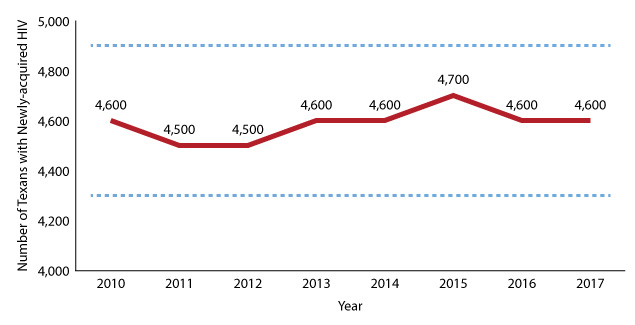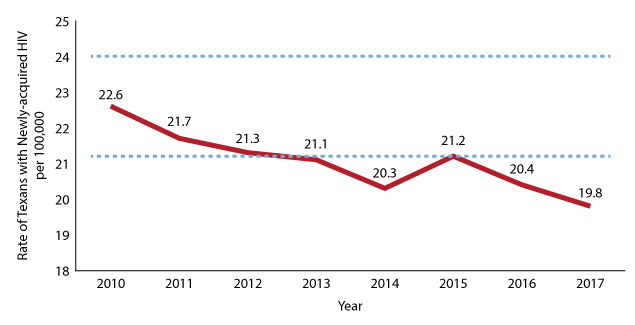Epi Profile Section 5 – Texans with Newly Acquired HIV
This section provides the estimated number and profile of Texans aged 13 and older who have newly acquired HIV infections (also called incidence). The number of people with newly acquired HIV is different from counts of people with newly diagnosed HIV. In the US, about 50% of people with HIV live with it for at least 3 years before they get a diagnosis. [11] Because of this delay, incidence shows the true leading edge of the epidemic.
The incidence estimates come from a model developed by the CDC. Information is available for 2010 through 2017. This model does not produce stable estimates for small groups and does not calculate estimates for transgender persons.
The information included in this section uses both midpoint estimates and 95% confidence intervals. The midpoint is the best estimate of the number of people with new HIV infections each year. We also use a confidence interval to mark off the range of values that we are 95% sure contains the true number of people with new HIV infections. On the graphs below, the midpoint estimates are shown as solid lines. The 95% confidence interval boundaries are shown as dotted blue lines.
As Figure 19 shows, the estimated number of Texans with newly acquired HIV did not change between 2010 and 2017: around 4,600 per year. This means that a Texan acquired HIV every two hours.
Figure 19: The estimated number of Texans with newly acquired HIV, 2010-2017

Source: Estimates of incidence run in 2019
Data for Figure 19
The rate of Texans with newly acquired infections fell significantly between 2010 and 2017 (Figure 20). The drop in the rate is likely due to the growth of the overall population of Texas, and not decreases in the number of Texans acquiring HIV each year.
Figure 20: Rate of Texans with newly acquired HIV per 100,000, 2010-2017

Source: Estimate of incidence run in 2019
Data for Figure 20
Although the overall number of people with new HIV infections did not significantly change, some key populations showed significant increases and decreases. We were able to estimate the number of people with newly acquired HIV in four of the five of the priority populations in the Texas HIV Plan: Hispanic MSM, Black MSM, White MSM, and Black women who have sex with men (WSM). We are not able to estimate the number of new infections in the fifth priority population, transgender people. [12]
Comparing 2017 to 2010 estimates show significant decreases in newly acquired HIV in White MSM and Black women who have sex with men. This means that Texas is making progress in driving down the number of people with new HIV infections in these groups. The number of Black MSM with newly acquired HIV was flat across the years. Unfortunately, the number of Hispanic MSM with new HIV infections showed significant increases from 2010 to 2017.
Figure 21: Newly acquired HIV in Texas HIV Plan priority populations, 2010-2017

*Statistically significant changes
Source: Estimates of incidence run in 2019
Profile of Texans with Newly Acquired HIV
Table 13 shows the profile for Texans with newly acquired HIV in 2017. As with new diagnoses, the greatest number of people with new HIV infections are MSM of color and those who are 13-34 years old.
Table 13: The profile of Texans with newly acquired HIV, 2017
| Demographics |
Estimated |
Lower Bound (95% Confidence |
Upper Bound (95% Confidence |
Rate |
|---|---|---|---|---|
|
Total |
4,600 |
3,800 |
5,300 |
19.8 |
|
Sex at birth |
||||
|
Male |
3,800 |
3,000 |
4,500 |
33.1 |
|
Female |
790 |
520 |
1,100 |
6.8 |
|
Race/Ethnicity |
||||
|
White |
720 |
460 |
990 |
7.1 |
|
Black |
1,600 |
1,200 |
2,000 |
58.8 |
|
Hispanic |
2,000 |
1,400 |
2,600 |
23.4 |
|
Age group (years) |
||||
|
13-24 |
1,200 |
750 |
1,600 |
23.9 |
|
25-34 |
1,900 |
1,400 |
2,400 |
45.4 |
|
35-44 |
830 |
490 |
1,200 |
21.7 |
|
45-54 |
470 |
220 |
730 |
13.4 |
|
55+ |
240 |
70 |
410 |
3.6 |
|
Transmission group |
||||
|
MSM |
3,000 |
2,300 |
3,600 |
|
|
PWID |
160 |
20 |
310 |
|
|
MSM/PWID |
220 |
30 |
410 |
|
|
Heterosexual sex |
790 |
490 |
1,100 |
|
|
Texas HIV priority population |
||||
|
Hispanic MSM |
1,398 |
899 |
1,896 |
|
|
Black MSM |
998 |
656 |
1,339 |
|
|
White MSM |
470 |
252 |
688 |
|
|
Black women who have sex with men |
343 |
163 |
522 |
|
The sum of the estimates of the age groups is greater than the total estimated incidence because of rounding in the calculation model.
Source: Estimates of incidence run in 2019
Note 11. cdc.gov/vitalsigns/hiv-testing/
Note 12. We are using the names of the priority populations as they appear in the Texas HIV Plan.
Texas HIV Epidemiologic Profile
